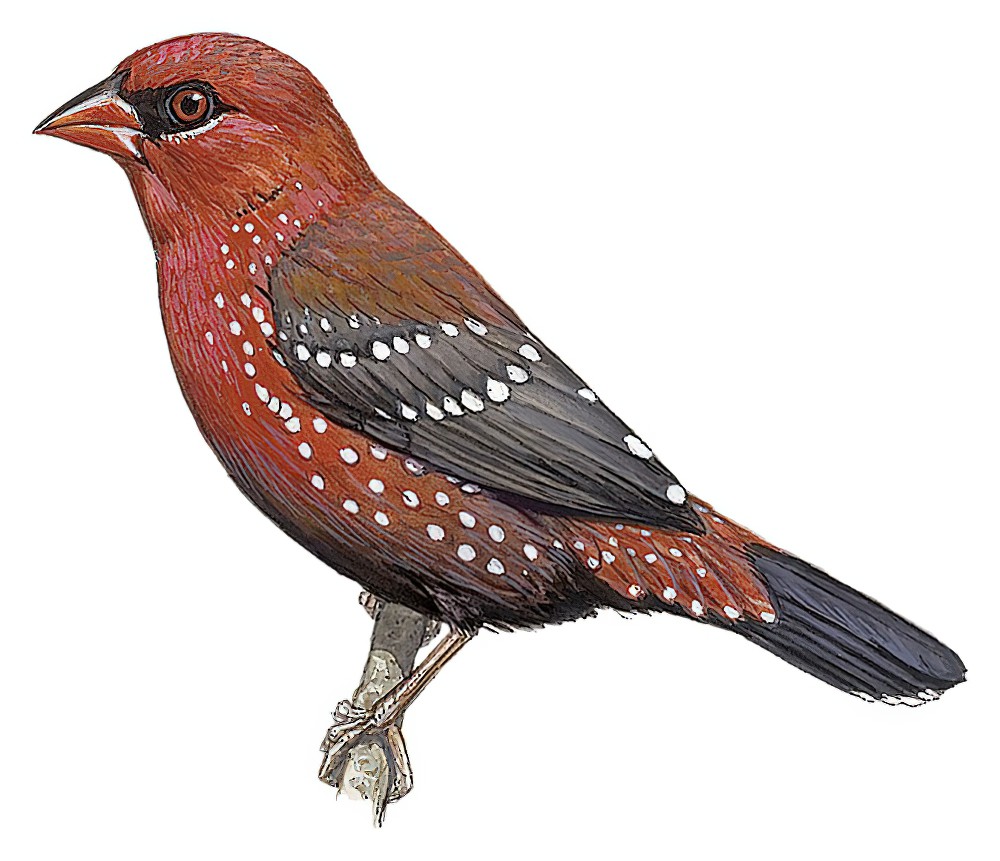Red Avadavat / Amandava amandava

Red Avadavat
SCI Name:
Protonym: Fringilla amandava Syst.Nat.ed.10 p.180
Taxonomy: Passeriformes / Estrildidae / Amandava
Taxonomy Code: redava
Type Locality: eastern India; restricted to Calcutta, West Bengal, by Baker, 1921, Journ. Bombay Nat. Hist. Soc, 27, p. 725 (Whistler and Kinnear, 1933, Journ. Bombay Nat. Hist. Soc, 36, p. 837, designate northern Gujerat, apparently unaware of the earlier restriction).
Author: Linnaeus
Publish Year: 1758
IUCN Status: Least Concern
DEFINITIONS
AMANDAVA
(Estrildidae; Ϯ Red Avadavat A. amandava) Specific name Fringilla amandava Linnaeus, 1758; "Many species of small birds are liable to be thus affected by feeding much upon hemp-seed; among others, the field-lark and the wood-lark, but none perhaps so readily as the alp, or "bull-finch" (pyrrhula vulgaris). Still it would appear that this diet is only a predisposing, not the real cause of this change of colour, for I have known the small tropical amandavat (amandava punctata? mihi, fringilla amandava Linnæus), of the bird-shops, to become wholly black when fed entirely on Canary-seed" (Blyth 1836); "Amandava Blyth, 1836, in White, Nat. Hist. Selborne, p. 44, ftn. Type, by monotypy, Amandava punctata Blyth = Fringilla amandava Linnaeus." (Paynter in Peters 1968, XIV, p. 348).
Synon. Sporaeginthus, Stictospiza.
amandava
Amandava, Amaduvad, Avadavad, Amadavad, Amadavada, Amadavat, Anadavad, and Averduvade, all former names for the Red Avadavat, are corruptions of Ahmadābād (formerly variously transcribed as Amadava, Madavá, Amadabat, Amidavad and Amadarar), a town of Gujerat, India, whence the first examples of this colourful cage-bird were brought; ex “Amadavad” or “Amaduvad” of Albin 1738 (Amandava).
AMANDAVA
(Estrildidae; Ϯ Red Avadavat A. amandava) Specific name Fringilla amandava Linnaeus, 1758; "Many species of small birds are liable to be thus affected by feeding much upon hemp-seed; among others, the field-lark and the wood-lark, but none perhaps so readily as the alp, or "bull-finch" (pyrrhula vulgaris). Still it would appear that this diet is only a predisposing, not the real cause of this change of colour, for I have known the small tropical amandavat (amandava punctata? mihi, fringilla amandava Linnæus), of the bird-shops, to become wholly black when fed entirely on Canary-seed" (Blyth 1836); "Amandava Blyth, 1836, in White, Nat. Hist. Selborne, p. 44, ftn. Type, by monotypy, Amandava punctata Blyth = Fringilla amandava Linnaeus." (Paynter in Peters 1968, XIV, p. 348).
Synon. Sporaeginthus, Stictospiza.
amandava
Amandava, Amaduvad, Avadavad, Amadavad, Amadavada, Amadavat, Anadavad, and Averduvade, all former names for the Red Avadavat, are corruptions of Ahmadābād (formerly variously transcribed as Amadava, Madavá, Amadabat, Amidavad and Amadarar), a town of Gujerat, India, whence the first examples of this colourful cage-bird were brought; ex “Amadavad” or “Amaduvad” of Albin 1738 (Amandava).
SUBSPECIES
Red Avadavat (Red-bellied)
SCI Name: Amandava amandava amandava/punicea
AMANDAVA
(Estrildidae; Ϯ Red Avadavat A. amandava) Specific name Fringilla amandava Linnaeus, 1758; "Many species of small birds are liable to be thus affected by feeding much upon hemp-seed; among others, the field-lark and the wood-lark, but none perhaps so readily as the alp, or "bull-finch" (pyrrhula vulgaris). Still it would appear that this diet is only a predisposing, not the real cause of this change of colour, for I have known the small tropical amandavat (amandava punctata? mihi, fringilla amandava Linnæus), of the bird-shops, to become wholly black when fed entirely on Canary-seed" (Blyth 1836); "Amandava Blyth, 1836, in White, Nat. Hist. Selborne, p. 44, ftn. Type, by monotypy, Amandava punctata Blyth = Fringilla amandava Linnaeus." (Paynter in Peters 1968, XIV, p. 348).
Synon. Sporaeginthus, Stictospiza.
Red Avadavat (Yellow-bellied)
SCI Name: Amandava amandava flavidiventris
flavidiventris
L. flavidus yellowish; venter, ventris belly.
UPPERCASE: current genus
Uppercase first letter: generic synonym
● and ● See: generic homonyms
lowercase: species and subspecies
●: early names, variants, mispellings
‡: extinct
†: type species
Gr.: ancient Greek
L.: Latin
<: derived from
syn: synonym of
/: separates historical and modern geographic names
ex: based on
TL: type locality
OD: original diagnosis (genus) or original description (species)












